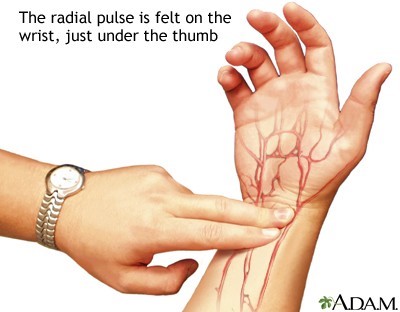When a person’s pulse is taken by palpation near the thumb on the wrist, which artery is felt?
Radial artery.
Palmar arch arteries.
Brachial artery.
Ulnar artery.
The Correct Answer is A

The radial artery is one of the major blood-supplying vessels to the forearm and hand.
It can be felt as a pulse near the thumb on the wrist by gently pressing the artery against the underlying bone.
This is the most commonly measured pulse by nurses to assess peripheral pulse characteristics.
Choice B.
Palmar arch arteries are wrong because these are branches of the radial and ulnar arteries that form anastomosis in the palm of the hand.
They are not palpable on the wrist.
Choice C.
The brachial artery is wrong because this is the main artery of the upper arm that bifurcates into the radial and ulnar arteries at the cubital fossa.
It can be felt as a pulse in the antecubital fossa, not near the thumb on the wrist.
Choice D
The Ulnar artery is wrong because this is another major blood-supplying vessel to the forearm and hand that runs along the medial aspect of the forearm.
It can be felt as a pulse on the little finger side of the wrist, not near the thumb.
Nursing Test Bank
Naxlex Comprehensive Predictor Exams
Related Questions
Correct Answer is C
Explanation
Basophils usually account for the smallest percentage of leukocytes in a blood sample. Basophils are a type of white blood cell that is involved in allergic reactions and inflammation.
Choice A is wrong because eosinophils are not the least common type of leukocyte.
Eosinophils are another type of white blood cell that is involved in allergic responses and parasitic infections.
They typically make up about 1-6% of the total leukocyte count.
Choice B is wrong because monocytes are not the least common type of leukocyte.
Monocytes are a type of white blood cell that can differentiate into macrophages and dendritic cells, which are important for phagocytosis and antigen presentation.
They typically make up about 2-10% of the total leukocyte count.
Choice D is wrong because neutrophils are not the least common type of leukocyte.
Neutrophils are a type of white blood cell that are the first responders to bacterial infections and tissue damage.
They typically make up about 55-70% of the total leukocyte count.
Correct Answer is B
Explanation
Veins are the type of blood vessel that holds the greatest volume of blood and serve as reservoirs for blood.

According to 1, veins contain about 70-80% of the blood volume in circulation.
Veins are also called capacitance vessels because they can expand and store more blood when needed.
Choice A. Capillary is wrong because capillaries are very thin and narrow vessels that allow the exchange of gases and nutrients between the blood and the tissues.
Capillaries have a very small volume compared to veins.
Choice C. Arteriole is wrong because arterioles are small branches of arteries that regulate blood pressure and blood flow to the capillaries.
Arterioles have a higher resistance and lower volume than veins.
Choice D. Artery is wrong because arteries are thick and muscular vessels that carry oxygen-rich blood away from the heart to the rest of the body.
Arteries have a higher pressure and lower volume than veins.
Normal ranges for blood volume vary depending on age, sex, weight, and health status, but generally range from 4 to 6 liters for adults.
Whether you are a student looking to ace your exams or a practicing nurse seeking to enhance your expertise , our nursing education contents will empower you with the confidence and competence to make a difference in the lives of patients and become a respected leader in the healthcare field.
Visit Naxlex, invest in your future and unlock endless possibilities with our unparalleled nursing education contents today
Report Wrong Answer on the Current Question
Do you disagree with the answer? If yes, what is your expected answer? Explain.
Kindly be descriptive with the issue you are facing.
